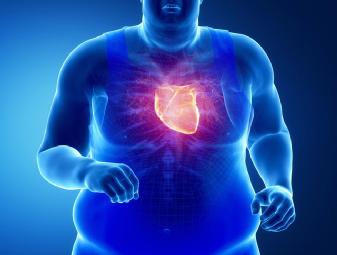As life expectancy increases, the incidence of heart disease increases day by day. Heart failure has become a medical problem that needs to be overcome urgently in the 21st century. Many studies in the past have shown that obesity is a risk factor for heart failure, but the discovery of the "obesity paradox" has made the truth more confusing.
The so-called "obesity paradox" refers to the clinical observation that patients with heart failure with higher BMI have a better prodigy than patients with lower BMI. It is unclear what mechanism obesity influences the prognosis of heart failure.

In animal models, diet-induced obesity can improve heart failure under certain conditions, but diet-induced obesity can also impair heart function, such as long-term high-fat diets that can lead to diabetic cardiomyopathy.
This phenomenon that is contrary to common sense suggests that there is an unknown mechanism behind it. Recently, the internationally renowned journal Circulation published a blockbuster study online, suggesting that the truth of the "obesity paradox" may be related to heart rhythm.
Rev-erbα/β is a nuclear receptor that plays a key role in regulating biological rhythms. The researchers first constructed a Rev-erbα/β knockout (KO) mouse model in which the mouse heart does not express the functional Rev-erbα/β protein. The effects of Rev-erbα/β on cardiac function were studied using knockout models compared with control groups.
doi: 10.1161/CIRCULATIONAHA.121.056076.
KO mice showed no significant abnormalities in circadian rhythms of exercise, energy expenditure, respiration, and food intake until they were normal in size, wall thickness, and contractile function of their left ventricles at 2.5 months of age.
However, at 4.5 months of age, KO mice began to exhibit impaired cardiac systolic function and an increase in the diameter of the left ventricle, but the ventricular wall had not yet seen significant thickening. By 6 months of age, their heart's ejection fraction had dropped to 20 to 30 percent, and the left ventricle was further dilated. Similar systolic dysfunction and cardiac dilation occur in female KO mice.
At the same time, cardiac systolic dysfunction in KO mice was associated with elevated ANP and BNP expression. Compared with the control, the inflammation gene of the heart of the KO mouse was not upregulated at 2 months of age, but was elevated at 4.5 months of age. Most KO mice die at 6 to 8 months of age.
In addition to heart disease, most of these KO mice have normal organs. Therefore, researchers believe that cardiomyocyte-specific knockout of Rev-erbα/β can lead to progressive systolic dysfunction, triggering dilated cardiomyopathy and fatal heart failure.
Given that Rev-erbα/β is closely related to circadian rhythms, the research team next conducted rhythm experiments on mice, dividing the mice's day into resting periods (light) and active periods (dark). Since the circadian rhythms of mice and humans are opposite, their resting periods and active periods are equivalent to human night and daytime, respectively.
The researchers took the heart tissue of mice every 4 hours for sequencing analysis. The results showed that the downregulated differential genes in KO mice were mainly enriched in metabolic pathways, especially fatty acid oxidation pathways. This suggests that Rev-erbα/β occupies a central position in myocardial energy metabolism.
Another major finding was that the fatty acid oxidation pathway in the hearts of KO mice lost rhythm and manifested itself in a persistent downturn. However, the glucose metabolic pathway gene peaked in the mouse active period. This may be because restrictions on the energy supply of fatty acids force enhanced glucose metabolism.
The researchers hypothesized that if impaired fatty acid oxidation caused the KO mice to have an increased demand for carbohydrates, leading to heart failure, it was possible to alleviate cardiac contractile dysfunction by increasing the ability of fatty acids to oxidize to alleviate their excessive dependence on sugar metabolism.
So they supplemented the active mice with a high-fat, sugar-free diet, but the high fat did not improve the energy metabolism patterns in the heart, nor did it improve heart function. This suggests that increasing lipid supply during the active phase does not by itself improve cardiac dysfunction in KO mice.
So they switched to supplementing mice with a high-fat diet during resting periods, which is equivalent to supplementing people with high-fat energy at night. Unsurprisingly, the mice showed bad signs of blood sugar and insulin levels, and obesity rates increased dramatically. However, fatty acid oxidation in KO mice was restored!
This suggests that providing more fatty acids for myocardial oxidative metabolism during resting periods can partially alleviate damage to the hearts of KO mice. Of course, as a double-edged sword, this can also lead to obesity.
From this, the researchers propose a possible explanation for the "obesity paradox": fatty acid metabolism disorders play a role in the occurrence of heart failure. Obese people can provide more fatty acids to the heart during rest, which can improve the heart's fatty acid metabolism, which in turn partially alleviates the damage to the heart.
For this study, the research team believes that its significance lies in revealing the important role of heart circadian rhythm in heart failure, and also providing a possible explanation for the "obesity paradox". But this does not mean advocating weight gain or eating a lot at night, but it suggests that the clinic should pay special attention to the drug delivery window in the treatment of heart failure.
Perhaps giving drugs at night to improve fatty acid metabolism would be the hope of another treatment for heart failure. What's more, this study made us realize that biorhythms need to be paid more attention to in the medical field, but at present, this is just easily overlooked clinically.
bibliography:
Shiyang Song, et al. Myocardial Rev-erb-Mediated Diurnal Metabolic Rhythm and Obesity Paradox. Circulation. 2022. doi: 10.1161/CIRCULATIONAHA.121.056076.
Written by | Official Mizuki
Edit | Swagpp